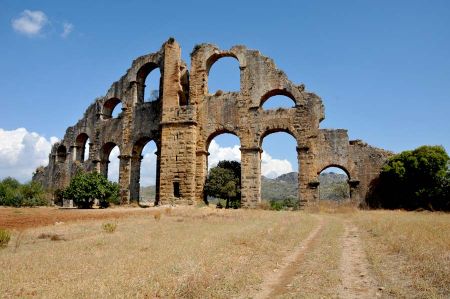Aqueduct - a water supply
An aqueduct is a water supply or navigable channel (conduit) constructed to convey water. In a more restricted use, aqueduct (occasionally water bridge) applies to any bridge or viaduct that transports water-instead of a path, road or railway-across a gap. Large navigable aqueducts are used as transport links for boats or ships.
Aqueducts must span a crossing at the same level as the watercourses on each side. The word is derived from the Latin aqua ("water") and ducere ("to lead").
Although particularly associated with the Romans, aqueducts were devised much earlier in the Near East and Indian subcontinent, where peoples such as the Egyptians and Harappans built sophisticated irrigation systems. Roman-style aqueducts were used as early as the 7th century BC, when the Assyrians built an 80 km long limestone aqueduct, 10 m high and 300 m wide, to carry water across a valley to their capital city, Nineveh.
Roman aqueducts were built in all parts of the Roman Empire, from Germany to Africa, and especially in the city of Rome, where they totalled over 415 km. The aqueducts supplied water to large cities across the empire, and set a standard of engineering that was not surpassed for more than a thousand years.
Historically, agricultural societies have constructed aqueducts to irrigate crops. Archimedes invented the water screw to raise water for use in irrigation of croplands.
In the past, aqueducts often had channels made of earth or other porous materials but significant amounts of water are lost through such unlined aqueducts. As water gets increasingly scarce, these canals are being lined with concrete, polymers or impermeable soil. In some cases, a new aqueduct is built alongside the old one because it cannot be shut down during construction.
The ancient Romans typically constructed numerous aqueducts to serve any large city in their empire, as well as many small towns and industrial sites. The city of Rome itself, being the largest city, had the largest concentration of aqueducts, with water being supplied by eleven aqueducts constructed over a period of 500 years. Scholars can even predict the size of the city by its water supply. They served potable water and supplied the numerous baths and fountains in the city, as well as finally being emptied into the sewers, where the once-used gray water performed their last function in removing waste matter.
The methods of construction are well described by Vitruvius in his work De Architectura written in the first century BC. His book would have been of great assistance to Frontinus, a general who was appointed in the late first century AD to administer the many aqueducts of Rome. He discovered a discrepancy between the intake and supply of water caused by illegal pipes inserted into the channels to divert the water, and reported on his efforts to improve and regulate the system to the emperor Trajan at the end of the first century AD. The report of his investigation is known as De aquaeductu. In addition to masonry aqueducts, the Romans built many more leads — channels excavated in the ground, usually with a clay lining. They could serve industrial sites such as gold mines, lead and tin mines, forges, water-mills and baths or thermo. Leads were very much cheaper than the masonry design, but all aqueducts required good surveying to ensure a regular and smooth flow of water.
